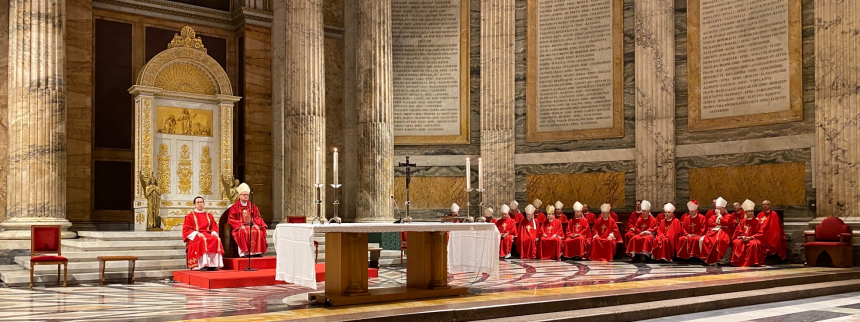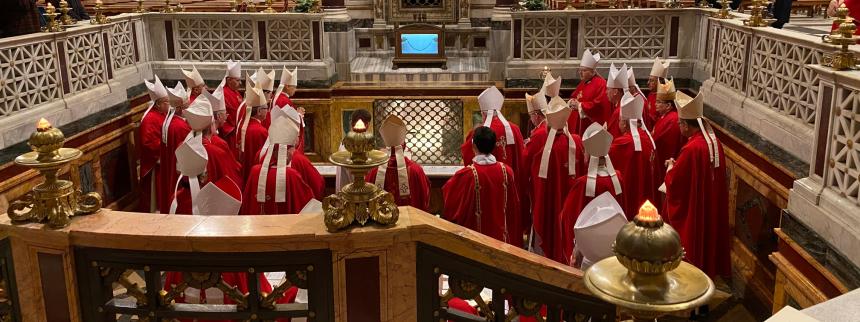
Bishop Jaime Soto shares the following reflections from his “ad limina” visit in Rome:
On the morning of the last day of the Ad Limina visit, my brother bishops, Bishop Weigand, and I offered Mass together at the Basilica of St. Paul Outside the Walls. The Basilica is built over the tomb of the Apostle to the Gentiles.
Bishop Michael Barber, the Bishop of Oakland, presided over the liturgy. In his homily, he reminded us of the missionary zeal inspired by the Basilica of St. Paul. Among those compelled by the tomb of St. Paul was the founder of the Jesuit community to which Bishop Barber belongs. In 1541, St. Ignatius of Loyola and his first followers made their vows as the Society of Jesus, in the same Basilica. Bishop Barber encouraged us to allow the proximity to the tomb inspire us with the same missionary zeal as we concluded the Ad Limina visit.
After the Mass, the bishops processed down to the tomb of St. Paul for prayer seeking his intercession. The silent stones of the tomb resonated with the adventurous saga of St. Paul and the early Church narrated in the Acts of the Apostles.
Seemingly improbable events were the mysterious hands of Divine Providence bringing both Paul and Peter to the City of Rome where they poured themselves out like a libation (II Tim. 4:6-7) for the sake of Christ and His gospel. Both Simon Peter and Paul were spared death in Jerusalem so that they could fulfill the Lord’s command to proclaim the gospel to all the nations. Their tombs in the City of Rome testify to the amazing achievement of a humble Galilean, born of the Virgin Mary, whose own life took him no further than Jerusalem on the periphery of the great Roman Empire.
Both Peter and Paul testified that Jesus of Nazareth, who was crucified under Pontius Pilate for our sins and raised up from the dead, is Lord of heaven and earth. All this gave a trembling silence to the gathering of apostolic successors from California, Nevada, and Hawaii.
St. Paul, along with Simon Peter, understood in a personal way the mercy shown each of them by Jesus’ sacrifice on the cross. It was for the remission of their sins that the blood of Jesus was poured out. This would be the heart of their testimony. “But God proves his love for us in that while we were still sinners Christ died for us.“ (Rom. 5:8) The depth with which Peter and Paul each personally felt the one love of Jesus was revealed by their martyrdom. Theirs was a startling, tranquil yet tremendous, reminder as we lingered over Paul’s tomb.
The root of the word “martyr” is witness. The radical witness of martyrdom prompts all disciples to be witnesses of Christ Jesus. Pope St. John Paul II, addressing the youth gathered in Rome for the Jubilee Year 2000, encouraged them and all of us, “Dear friends, to believe in Jesus today, to follow Jesus as Peter, Thomas, and the first Apostles and witnesses did, demands of us, just as it did in the past, that we take a stand for him, almost to the point at times of a new martyrdom: the martyrdom of those who, today as yesterday, are called to go against the tide in order to follow the divine Master, to follow ’the Lamb wherever he goes’” (Rev 14:4).
That Peter and Paul were made martyrs in Rome was also a consequence of their missionary zeal. Pope Francis challenges all of us, especially bishops, to kindle a missionary zeal as an essential part of discipleship, to be “missionary disciples”. In the history of the Church, martyrdom was often part of being a missionary: San Jean Brébeuf and the French Jesuits in North America, San Felipe de Jesús and San Lorenzo Ruiz in Japan, the Vietnamese and Korean martyrs all made an offering of their lives while serving as missionaries.
As with Peter and Paul, the graces of missionary and martyrdom, come from conversion and purification. They are also the test of true conversion and purification. It is the Christian exodus. As St. John Paul II said at the beginning of the new millennium, “to go against the tide in order to follow the divine Master, to follow the Lamb wherever he goes.” The two great apostles were forgiven for their grave sins, the shameful denials of Peter and the savage persecutions of Paul, by the blood of the Lamb of God mercifully poured out on the cross. Their love of the crucified Christ, who had first loved them (I Jn. 4:19), made them missionaries and martyrs. As Paul came to embrace, “I live, no longer I, but Christ lives in me; insofar as I now live in the flesh, I live by faith in the Son of God who has loved me and given himself up for me.” (Gal. 2:20)
Their personal testimony of Christ’s mercy is what they share in synagogues, homes, public squares, and Roman tribunals. Others came to know Christ as they shared what the Lord had done for them. This is how the story of divine mercy began. It is how it will continue.
This cloud of witnesses, missionaries and martyrs, hovered over us as we concluded the Ad Limina pilgrimage only to see more clearly the merciful exodus to which Jesus, our Good Shepherd continues to beckon us.
Read all Ad Limina reflections
- "The personal relationship with Jesus is the soul of the apostolic tradition"
- 'We are also bound closely to Christ who has called us to love Him and feed His flock'
- 'It is an avenue to walking more closely in the light of Christ'
- 'The radical witness of martyrdom prompts all disciples to be witnesses of Christ Jesus'



